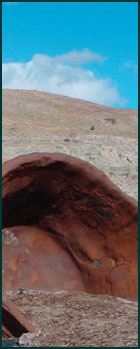By Ashley Fingarson

The Old Works Golf Course just outside Anaconda is extraordinary. Set against the Pintlar mountains, the course incorporates remnants of the Upper and Lower Old Works–two copper smelters that started operation in 1883 and were shut down in 1903. Ruins of old buildings surround the course. Smelter ladles the size of golf carts–ladles that once carried molten copper to and from the furnace–lie near the first tee. What is left of an old brick flue runs up a nearby hill– one can almost envision the smokestack that once stood at the crest. A pile of black slag rises above the green fairways like a mesa. The famous Washoe Works smokestack (once the largest volume smokestack in the world) is visible across the valley.
This stunning golf course did not come cheap. The transformation of a contaminated site under the control of the Environmental Protection Agency to a world class golf course cost $49 million, according to the Atlantic Richfield Company, which paid the bills. (The company was known as ARCO until it became a subsidiary of British Petroleum in 2000). “This includes everything from design of the course, to cleaning up, capping the contaminants, studies leading up to the design, and building the golf course itself,” says Marci Sheehan, associate environmental manager at Atlantic Richfield. Golf courses typically cost between $2 and $8 million.
Anaconda is thirty miles from the once-rich copper hill in Butte, Montana. Copper tycoon Marcus Daly built two smelters there, but closed them in 1903 after constructing the more modern Washoe Works across the valley. Over the years, smelting left its mark around Anaconda in the form of black slag mounds and the less visible but widespread contamination of soil and water from the wastes.
In 1977, ARCO purchased the Anaconda Copper Mining Company, a remnant of Marcus Daly’s empire. But copper prices fell soon after, and ARCO closed the Washoe Works in 1980, leaving the town depressed.
Three years later, matters worsened. The Environmental Protection Agency designated the Upper Clark Fork river basin, a 118-mile stretch from Butte to Missoula, as a Superfund site–the nation’s largest. The EPA named ARCO as the “potentially responsible party.” That meant that ARCO had to clean it up.
Since then, Atlantic Richfield has spent over $130 million decontaminating and rehabilitating the area, and the job is far from finished. But the Superfund cloud had a copper lining.
In 1988, Gene Vuckovich, the manager of the city of Anaconda and the county of Deer Lodge, proposed turning the sterile Old Works land into a golf course. Tom Litman, now a golf pro at Old Works, recalls, “There were some skeptics when it was first talked about, but anything is possible with ARCO, which is one of the biggest corporations in the world, a subsidiary of British Petroleum.” Vuckovich worked with Atlantic Richfield and brought in Jack Nicklaus, after interviewing seven of the top ten golf course designers in the country. “We didn’t want any old course,” says Vuckovich in a video describing the history of the golf course (Atlantic Richfield Co. n.d.).
Nicklaus began designing the links in 1992, and the course was officially opened in 1997. Crushed limestone covers the smelting waste, and sixteen inches of clean topsoil make up the base of the golf course. The irrigation system was designed to prevent contaminants from entering Warm Springs Creek, which flows through the course. Excess water is collected and moved to an evaporating pond so that it doesn’t seep into the soil, where it could leach contaminants.
Nicklaus incorporated the black slag into sand traps. He found that the slag is easier to play in–“It’s heavier than sand, and balls don’t sink in it and become covered.” In fact, Nicklaus only had one concern with the course. “The trouble is–you’re going to have to figure out how to play white sand after this” (Atlantic Richfield Co. n.d.). The 18-hole golf course is comparatively long at 7,700 yards.
Deer Lodge County owns Old Works, which is open to the public. Although Old Works’ net revenues will never cover the costs of decontamination, the course does cover its operating costs, which are between $1.2 and $1.4 million each year. For the first ten years of operation, earnings are being placed into a reserve account. Once the reserve is met, the county will use its net revenues for purposes such as parks or historic preservation.
“This golf course has definitely helped the economy tremendously,” says Litman. “Without the golf course, Anaconda would be a ghost town–a slight exaggeration, but there are not many jobs here.” About 22,000 rounds of golf are played at Old Works each year, about half by out-of-state visitors. The facility has been featured in numerous golf magazines–at least once every year since it opened, according to Litman.
In spite of its high cost, Anaconda’s experience may have set a precedent. Litman notes that in Casper, Wyoming, an AAMCO refinery is also a cleanup site. A proposed golf course there should be completed by 2005. Robert Trent Jones, whose grandfather is famed golfer Bobby Jones, is working on the design there, Litman says.
REFERENCES
Atlantic Richfield Company. 1993. Progress on the Old Works Golf Course. Old Works News (ARCO newsletter). Billings, MT.
—. 1994. The Ground is Broken. Old Works News (ARCO newsletter). Billings, MT, July.
—. 2002. Anaconda Regional Water, Waste and Soils. In The Clark Fork River Basin Environmental Action Plan. Anaconda, MT. Summer, 38-42.
—. N.d. Old Works: Vision to Reality. Video. Butte, MT: Maney Telefilm.
Ashley Fingarson, a student at Montana State University, has written two other articles for PERC Reports.


